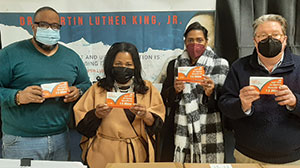Progress Made in COVID Cases, Positivity Rate, But Hurdles Remain

New York State has seen a significant drop in COVID-19 cases over the past week, giving officials hope that the worst days of this winter’s surge fueled by the Omicron variant may soon be over.
Positive cases fell on Sunday to 26,772, for a 13.1 percent statewide infection rate, although the numbers may be somewhat skewed because there was about one-third to one-half the number of tests administered during the middle of the long holiday weekend, according to the state COVID-19 tracker. There were only 204,126 people tested, down from between 300,000 to nearly 400,000 each one of the preceding five days.
However, even before what could be a statistical anomaly, daily positives and the percentage of positive cases have declined from a high of 90,132 on Jan. 7 and a more than 22 percent infection rate to a low of 47,840 new cases on Jan. 13. The daily infection rate fell to 12.9 percent on Saturday and 13.1 percent on Sunday.
“This is a very positive trend and I believe we’re going to be able to keep that going,” Gov. Kathy Hochul said. “I want to thank New Yorkers, thank you for hanging in there with us through 2020, 2021 and hopefully not too much of 2022, and it’s because you got vaccinated, you wear your masks.”
However, the state is not out of danger just yet, the governor warned. COVID-19 hospitalizations are still very high at 11,751 as of Sunday, including 1,196 newly-admitted patients statewide. There were also 152 deaths throughout New York on Jan. 16.
Additionally, available hospital beds were dwindling in several upstate regions that were near or below 10 percent as of Sunday, the threshold set by Hochul to suspend elective surgeries. The Finger Lakes region had just 5 percent of its hospital beds available while the Capital region availability stood at 9 percent. The Mohawk Valley had 10 percent availability with Western New York and Central New York at 11 percent each and the Southern Tier at 12 percent.
The Mid Hudson Region, which includes Westchester and Putnam counties, had 17 percent of its hospital beds empty. New York City had 16 percent and Long Island 23 percent.
“They’re still too high,” Hochul said of the hospitalizations. “I mean 12,000 is not something we’re saying is a positive news story. It is still very high, but this will hopefully catch up with the trend (of lower cases) that’s happening.”
She said the areas with the low hospital bed availability have among the lowest vaccination rates in the state. Hochul said the most alarming statistic was that 91 percent of newly hospitalized five- to 11-year-olds are unvaccinated.
“It doesn’t have to be that way,” the governor said. “Unnecessary, preventable and that’s what we’re going to keep talking about, is how to make sure that we get our kids protected.”
Westchester’s positivity rate declined to 12.2 percent with 978 new positives on Sunday, down from 2,171 new cases on Saturday, although just 8,078 people were tested Sunday, just under half the number from the day before.
The state reported that Putnam County had 134 new positives, for a 17.3 percent rate on Sunday.
Despite the declining number of new daily cases in Westchester, active cases from the last update on Thursday, Jan. 13 reached 47,069, more than 11,000 additional cases from the previous reporting from Jan. 9. The county hand not updated that figure since Jan. 13.
While the infection rate and the raw number of cases are declining, Hochul was non-committal last Friday about whether she will lift the statewide indoor public space mask mandate at the end of the month. She initially called for the mandate to start on Dec. 13 and run until Jan. 15, then earlier this month extended it through the end of January.
Hochul said state health officials will continue to monitor the situation and make the best call when a decision has to be made.
“They’ll come a time when we assess this, we’ll determine if any protections need to be put in place any longer, but in my opinion, the sooner the better to allow people to feel liberated from this pandemic and we’ll be delighted to make the announcement at the right time,” she said.

Martin has more than 30 years experience covering local news in Westchester and Putnam counties, including a frequent focus on zoning and planning issues. He has been editor-in-chief of The Examiner since its inception in 2007. Read more from Martin’s editor-author bio here. Read Martin’s archived work here: https://www.theexaminernews.com/author/martin-wilbur2007/
